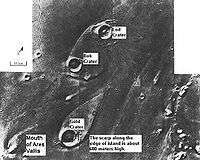Maja Valles
|
Waters from Vedra Valles, Maumee Valles, and Maja Valles went from Lunae Planum on the left, to Chryse Planitia on the right. Image is located in Lunae Palus quadrangle and was taken by Viking Orbiter. | |
| Coordinates | 12°36′N 58°18′W / 12.6°N 58.3°WCoordinates: 12°36′N 58°18′W / 12.6°N 58.3°W |
|---|---|
Maja Valles is a large, ancient outflow channel in the Lunae Palus quadrangle on Mars. Its location is 12.6° north latitude and 58.3° west longitude. The name is a Nepali word for "Mars".[1] Maja Valles begins at Juventae Chasma. Parts of the system have been partially buried by thin volcanic debris. Maja Valles ends at Chryse Planitia.[2]
Huge outflow channels were found in many areas by the Viking Orbiters. They showed that floods of water broke through dams, carved deep valleys, eroded grooves into bedrock, and traveled thousands of kilometers.[3][4][5]
- Area around Northern Kasei Valles, showing relationships among Kasei Valles, Bahram Vallis, Vedra Valles, Maumee Valles, and Maja Valles. Map location is in Lunae Palus quadrangle and includes parts of Lunae Planum and Chryse Planitia.
 Tear-drop shaped islands caused by flood waters from Maja Valles, as seen by Viking Orbiter. Image is located in Oxia Palus quadrangle.
Tear-drop shaped islands caused by flood waters from Maja Valles, as seen by Viking Orbiter. Image is located in Oxia Palus quadrangle. Streamlined islands seen by Viking showed that large floods occurred on Mars. Image is of a small part of Maja Valles and is located in Lunae Palus quadrangle.
Streamlined islands seen by Viking showed that large floods occurred on Mars. Image is of a small part of Maja Valles and is located in Lunae Palus quadrangle. Scour patterns, located in Lunae Palus quadrangle, were produced by flowing water from Maja Vallis, which lies just to the left of this mosaic. Detail of flow around Dromore Crater is shown on the next image.
Scour patterns, located in Lunae Palus quadrangle, were produced by flowing water from Maja Vallis, which lies just to the left of this mosaic. Detail of flow around Dromore Crater is shown on the next image. Great amounts of water were required to carry out the erosion shown in this Viking image of a small part of Maja Valles. Image is located in Lunae Palus quadrangle.
Great amounts of water were required to carry out the erosion shown in this Viking image of a small part of Maja Valles. Image is located in Lunae Palus quadrangle. Maja Valles streamlined island, as seen by HiRISE. Island formed behind the impact crater at the lower right.
Maja Valles streamlined island, as seen by HiRISE. Island formed behind the impact crater at the lower right.- Map of Lunae Palus quadrangle with labels. Maja Valles is large ancient river valley.
References
- ↑ http://planetarynames.wr.usgs
- ↑ Baker, V. 1982. The Channels of Mars. University of Texas Press. Austin
- ↑ ISBN 0-8165-1257-4
- ↑ Raeburn, P. 1998. Uncovering the Secrets of the Red Planet Mars. National Geographic Society. Washington D.C.
- ↑ Moore, P. et al. 1990. The Atlas of the Solar System. Mitchell Beazley Publishers NY, NY.
This article is issued from Wikipedia - version of the 7/12/2014. The text is available under the Creative Commons Attribution/Share Alike but additional terms may apply for the media files.
